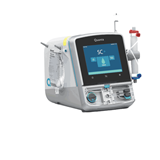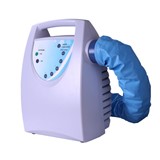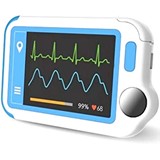The study, led by Dr. Sanjay Rajagopalan, a cardiologist in the Ohio State University Medical Center, examined the health records of nearly 30,000 dialysis patients enrolled from 1996 to 2004 in the Dialysis Outcomes and Practice Patterns Study (DOPPS) in North America, Europe, Japan and Australia.
Researchers found that just over one-quarter of the patients had PAD, and that the incidence varied considerably according to country, affecting only 12 percent of the dialysis patients in Japan, but 38 percent of those living in Belgium.
Peripheral arterial disease occurs when cholesterol or plaque builds up in the arteries outside the heart – typically in the legs or pelvis – limiting normal blood flow and increasing the risk of heart attack or stroke.
It is estimated that about 3 percent of the American population younger than 60 years old has some degree of PAD, although they may not be aware of it because the early symptoms are often subtle and attributed to something else.
The frequency of the disorder increases with age, with more than 20 percent of individuals above age 70 suffering from some form of it.
“We always knew that patients on dialysis had a greater risk of PAD, but until now, no one has really looked at how the disease affects their long-term survival or quality of life,” says Rajagopalan, who is associate director for vascular research at the Davis Heart and Lung Research Institute. “Basically, we found that if a patient is on dialysis, a diagnosis of PAD increases their overall risk of dying by 36 percent.”
Investigators found an even higher risk of death among those with PAD who had no prior history of heart attack or stroke – even though they were more likely to be users of statins or aspirin, medicines believed to lower the risk of those events.
Rajagopalan says he believes this underscores the value of PAD as a prognostic indicator. “What the data is telling us is that peripheral artery disease is very, very serious – just as serious as having had a heart attack or a stroke. It is not a pretty picture.”
The study found that dialysis patients with PAD, when compared to those patients without the disease, were generally about twice as likely to be suffering from a number of other conditions that increased their risk of death, including coronary artery disease, congestive heart failure, cerebrovascular disease or diabetes.
In comparing the disease profile among Americans with those in other countries, the researchers found that while the odds of having PAD were significantly higher in France and Belgium, they were 48 percent lower in Japan.
They also found that although the impact of PAD on overall survival is evident in patient populations everywhere, patients in Japan had significantly better survival than their counterparts elsewhere.
Rajagopalan says the variation could be due to several factors. One could be that clinicians in varying countries used different criteria in enrolling patients in the DOPPS registry.
Since there is no discrete clinical measure that automatically generates a diagnosis of PAD, some patient populations might reflect more serious manifestations of the disease than others.
In addition, he says scientists have known for some time that certain populations – among them, the Japanese – have a lower incidence of cardiovascular disease, a phenomenon presumably linked to their diet, but which may also be linked to genetics, as well – both factors which could conceivably play a role in overall survival.
“There are limitations to every study and to every registry, but we feel that these data are important because they are helpful in identifying a subset of dialysis patients who are at very high risk of heart attack or stroke and who might benefit from the most aggressive medical intervention available, using the best evidence based approach” says Rajagopalan.
Collaborators on the study, funded by Amgen and Kirin, include Santo Dellegrottaglie, a research fellow in Mount Sinai Medical Center, who is an equal co-author with Rajagopalan.
- Suppliers
- New to MedicalSearch? Book a Demo
- Advertise with us
- Login
- Email Marketing
- Buyers
- Get Quotes
- Articles & Ideas
- Login
- Subscribe to newsletter
- My Details
- Get Quotes
- Accident & Emergency Care
- Aged Care & Disability
- Anaesthesia & Respiratory Care
- Beauty & Wellness
- Cardiology & Cardiac Surgery
- Commercial Cleaning & Laundry Supplies
- Dental Care & Oral Surgery
- Diagnostic Instruments & Medical Imaging
- Disinfection & Sterilisation
- ENT & Audiology
- Gynaecology & Obstetrics
- Homecare & Consumer Medical
- Hospital Equipment & Supplies
- Intensive Care Unit
- Laboratory & Pathology
- Medical Apparel
- Medical Devices & Products
- Medical Fridges & Freezers
- Medical Storage & Filing
- Medical Waste Management
- Optometry & Ophthalmology
- Orthopaedics & Podiatry
- Paediatrics & Neonatology
- Patient Monitoring & Management
- Physiotherapy & Rehabilitation
- PPE & Infection Control
- Single Use Medical Consumables
- Surgical Tools & Supplies
- Treatment Beds, Tables & Couches
- Veterinary Equipment
- Wheelchairs & Mobility Aids
- Get Quotes
- Accident & Emergency Care
- Aged Care & Disability
- Anaesthesia & Respiratory Care
- Beauty & Wellness
- Cardiology & Cardiac Surgery
- Commercial Cleaning & Laundry Supplies
- Dental Care & Oral Surgery
- Diagnostic Instruments & Medical Imaging
- Disinfection & Sterilisation
- ENT & Audiology
- Gynaecology & Obstetrics
- Homecare & Consumer Medical
- Hospital Equipment & Supplies
- Intensive Care Unit
- Laboratory & Pathology
- Medical Apparel
- Medical Devices & Products
- Medical Fridges & Freezers
- Medical Storage & Filing
- Medical Waste Management
- Optometry & Ophthalmology
- Orthopaedics & Podiatry
- Paediatrics & Neonatology
- Patient Monitoring & Management
- Physiotherapy & Rehabilitation
- PPE & Infection Control
- Single Use Medical Consumables
- Surgical Tools & Supplies
- Treatment Beds, Tables & Couches
- Veterinary Equipment
- Wheelchairs & Mobility Aids
Trusted by 520,000 Australian medical buyers
Buyers
- Discover products & solutions
- Login
- Subscribe To Newsletter
- Browse All Products
- Read Articles
Suppliers
Advertise
- Promote your products & solutions
- New to MedicalSearch? Book a Demo
- Login / Forgot Password
- Advertise Your Products
- Success Stories
- Email Marketing
- Suppliers
- Advertise with us
- Login
- Email Marketing
- Buyers
- Get Quotes
- Articles & Ideas
- Login
- Subscribe to newsletter
- My Details
Get Quotes
- Accident & Emergency Care
- Aged Care & Disability
- Anaesthesia & Respiratory Care
- Beauty & Wellness
- Cardiology & Cardiac Surgery
- Commercial Cleaning & Laundry Supplies
- Dental Care & Oral Surgery
- Diagnostic Instruments & Medical Imaging
- Disinfection & Sterilisation
- ENT & Audiology
- Gynaecology & Obstetrics
- Homecare & Consumer Medical
- Hospital Equipment & Supplies
- Intensive Care Unit
- Laboratory & Pathology
- Medical Apparel
- Medical Devices & Products
- Medical Fridges & Freezers
- Medical Storage & Filing
- Medical Waste Management
- Optometry & Ophthalmology
- Orthopaedics & Podiatry
- Paediatrics & Neonatology
- Patient Monitoring & Management
- Physiotherapy & Rehabilitation
- PPE & Infection Control
- Single Use Medical Consumables
- Surgical Tools & Supplies
- Treatment Beds, Tables & Couches
- Veterinary Equipment
- Wheelchairs & Mobility Aids
Get Quotes
- Accident & Emergency Care
- Aged Care & Disability
- Anaesthesia & Respiratory Care
- Beauty & Wellness
- Cardiology & Cardiac Surgery
- Commercial Cleaning & Laundry Supplies
- Dental Care & Oral Surgery
- Diagnostic Instruments & Medical Imaging
- Disinfection & Sterilisation
- ENT & Audiology
- Gynaecology & Obstetrics
- Homecare & Consumer Medical
- Hospital Equipment & Supplies
- Intensive Care Unit
- Laboratory & Pathology
- Medical Apparel
- Medical Devices & Products
- Medical Fridges & Freezers
- Medical Storage & Filing
- Medical Waste Management
- Optometry & Ophthalmology
- Orthopaedics & Podiatry
- Paediatrics & Neonatology
- Patient Monitoring & Management
- Physiotherapy & Rehabilitation
- PPE & Infection Control
- Single Use Medical Consumables
- Surgical Tools & Supplies
- Treatment Beds, Tables & Couches
- Veterinary Equipment
- Wheelchairs & Mobility Aids
Trusted by 520,000 Australian medical buyers


-160x160-state_article-rel-cat.png)
-160x160-state_article-rel-cat.png)









